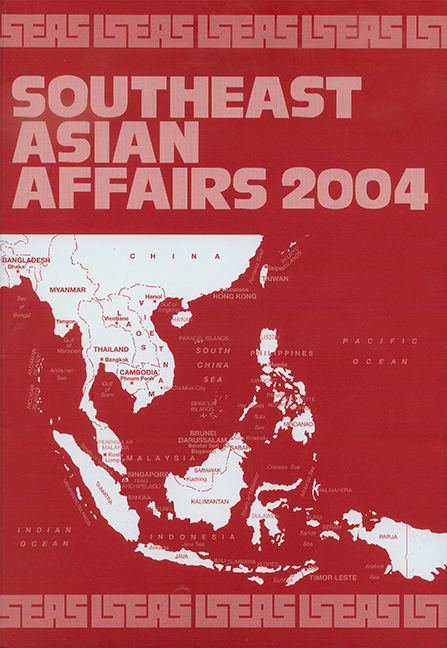Book contents
- Frontmatter
- FOREWORD
- Contents
- INTRODUCTION
- THE REGION
- ASEAN in 2003: Adversity and Response
- Southeast Asia's Economic Performance: Achievements and Challenges
- Southeast Asia–China Relations: Dialectics of “Hedging” and “Counter-Hedging”
- Terrorism in Southeast Asia: The Ideological and Political Dimensions
- BRUNEI DARUSSALAM
- CAMBODIA
- INDONESIA
- LAOS
- MALAYSIA
- MYANMAR
- THE PHILIPPINES
- SINGAPORE
- THAILAND
- TIMOR LESTE
- VIETNAM
Terrorism in Southeast Asia: The Ideological and Political Dimensions
from THE REGION
Published online by Cambridge University Press: 21 October 2015
- Frontmatter
- FOREWORD
- Contents
- INTRODUCTION
- THE REGION
- ASEAN in 2003: Adversity and Response
- Southeast Asia's Economic Performance: Achievements and Challenges
- Southeast Asia–China Relations: Dialectics of “Hedging” and “Counter-Hedging”
- Terrorism in Southeast Asia: The Ideological and Political Dimensions
- BRUNEI DARUSSALAM
- CAMBODIA
- INDONESIA
- LAOS
- MALAYSIA
- MYANMAR
- THE PHILIPPINES
- SINGAPORE
- THAILAND
- TIMOR LESTE
- VIETNAM
Summary
The 12 October 2002 bomb blasts that obliterated two packed nightclubs in Bali and killed 202 mainly Australian tourists, riveted international attention on the threat of radical Islamist terrorism in Southeast Asia. In an ominous echo of previous bombings in the Middle East, Chechnya, and elsewhere, the tactic of suicide bombing was employed in the attacks. Worryingly, moreover, Bali was not the only attack. Throughout 2003, a series of smaller blasts rocked the southern Philippines and Indonesia, culminating in the 5 August 2003 car bombing of the American-owned JW Marriott Hotel in Jakarta. Another eleven people were killed and about 150 injured this time. Indonesian police investigations quickly uncovered the role of yet another suicide bomber. Ominously, it was revealed that had the suicide bomber not detonated his bomb prematurely, he might have killed 200 people in the Marriott. Both the Bali and Jakarta Marriott attacks were said to be the work of the shadowy radical Islamist terror network Jemaah Islamiyah (JI). The global media lost little time in declaring that the JI and its putative patron, the global jihadi network Al-Qaeda, had together “turned Southeast Asia into a terrorist haven”.5 Even the arrest of the Indonesian Riduan Isamudin, alias Hambali, the operational commander of the JI, in Thailand on 11 August 2003, did not appear to calm jitters. U.S. Deputy Secretary of State Richard Armitage declared publicly that “a general threat” still existed.
One compelling reason why the “general threat” of radical Islamist terrorism still exists, despite the capture of senior terrorist leaders such as Hambali, is the vitality of the underlying ideology animating jihadi networks such as the JI and Al-Qaeda. This brief article attempts to lay bare the main tenets of the radical Islamist ideology that drives jihadi networks in Southeast Asia. It will also explore the regional and global political elements that fuel Southeast Asian jihadi ideology. For reasons of space, the article will focus on the most important of the jihadi networks in the region, the JI.
- Type
- Chapter
- Information
- Southeast Asian Affairs 2004 , pp. 54 - 60Publisher: ISEAS–Yusof Ishak InstitutePrint publication year: 2004



